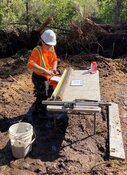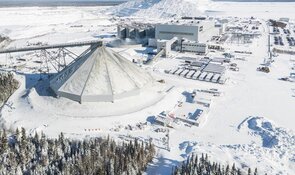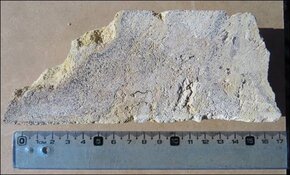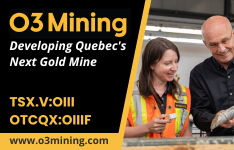Brent Cook: Investors should consider that most of the new companies coming in now are trying to take advantage of the gold price. Longtime gold investor Rick Rule has a classic statement that the only thing that limits the supply of paper that the Canadian market can print is the number of trees between British Columbia and Newfoundland. To some degree, that is very accurate. I think it is important to be even more diligent in reviewing companies today. Investors should look at management, share structure and the prospectivity of the projects the companies are actually planning to spend your money on. That is key.
TGR: Some companies may simply be springing up to take advantage of the rising price of gold, but there must be some legitimate new companies. Is the gold price making some projects economically viable?
BC: Certainly. If you run a geologic and economic model on a mine—let's say 0.7 grams per ton (g/t)—it could be economic with gold at about $1,300/oz. but not when gold was at $1,000/oz. You still have to look at that profit margin, plus the size of the capital needed to build the mine. I think we are going to see a lot of companies that have marginal deposits start to be put into production. Those deposits rely on the gold price staying above $1,000/oz. or more.
TGR: Is there a possibility that the gold price will come down to a point where those projects would not be economically viable?
BC: A slight shock to the gold price can and will destroy these companies mining marginal deposits. We have seen this happen countless times in the past and it will happen again. When is the big unknown. I think gold is much more likely to go higher than lower over the next few years based on my read of global economic and political issues. I suspect gold prices will be higher three years from now and six years from now; however, I am not a banker. If a company finds a deposit now, it is going to be two to three years to drill it out and another two to three years to permit it, put it into production and raise the money. That company would be facing a minimum of six years to put a legitimate, reasonably sized gold mine into production. So, what is the gold price going to be six years from now? Are the banks willing to finance a project based on today's $1,339/oz. gold price six years out from now? Certainly the brokerage firms and such are, but they make their money on commissions. By the time the mine is making or losing money, they are long gone and on to the next new thing.
TGR: What is the baseline gold price that you use to determine if a project is economically viable?
BC: I use a variety of prices, to be honest with you. In my letter, I try and let subscribers judge the merits of a project using their own gold price assumptions but my hard data and analysis. What I really look at is the robustness of the deposit. Does the property offer the potential of a long-lived mine with excellent exploration potential and fairly rapid payback of capex? That is the type of deposit a major company is going to buy, and that is really what I want to focus on. I know there will be very few of these large, high-margin deposits discovered over the next few years. However, given the cash flow these miners are generating now, plus the high multiples the market is awarding them, they can and will pay a premium for the few best deposits. I will leave the marginal systems or deposits for someone else to try and make work.
TGR: Is there a specific area or type of gold project that majors are looking for and are more likely to buy?
BC: The majors are really after something that has multimillion-ounce potential. Any gold project that a mining company buys right now is not going to be cheap, so they want to know there is not just 1–2 million ounces (Moz.) in defined resources and that the geologic system is capable of hosting another 2, 4 or 5 Moz. of assets. They will overpay for the defined ounces if they see a good probability that it is a much larger system and the deposit will grow over time into a multimillion-ounce deposit. That is what I'm looking for as early as possible.
TGR: To what extent does the type of mining used to extract the gold influence the project's desirability?
BC: It influences it a fair bit, but again, it comes down to margins. Obviously, an underground mine needs a higher grade than an open-pit oxide deposit. An open-pit sulfide deposit has higher processing costs than an oxide deposit. So, again, it's not grade per se but the cost to get the metal out of the rock. But that's a good point because a common question I get is, "What's good grade and what's bad grade?" Well, you can't really say what's good or bad grade until you have some sense of what it's going to cost to mine that grade. For example, 0.7 grams of oxide sitting at the surface in Nevada is a very rich deposit; but 0.7 grams of refractory sitting in Kazakhstan is not economic. In the back of my mind, I always have what it's going to cost to mine and process a deposit. Then I consider if the grades reported are sufficient to justify the work.
TGR: Are there certain regions that the majors are looking at for consolidation of current projects?
BC: I would say it is always the same regions. Certainly, the Cordillera, the Andes and Patagonia all the way up to Alaska. West Africa is a very hot place right now, very prospective—Burkina Faso, Mali, the Ivory Coast—those are great places to be. Colombia is also hot right now. I think there will be some real discoveries there, but you've got to be careful because, like the Yukon, there's so much gold there that any company can go in and acquire a project—90% of those are not going to be viable, large deposits.
TGR: The Yukon has come out of nowhere. Everybody is buzzing about the Yukon now.
BC: This is interesting. We have always known there was placer gold there—a lot of placer gold—and no one's really put the effort into finding where that came from. That's changed recently with what started off as a discovery by Underworld Resources that was bought by Kinross Gold Corp. (TSX:K; NYSE:KGC). Now, Kaminak Gold Corporation (TSX.V:KAM) has a discovery, ATAC Resources Ltd. (TSX.V:ATC) has a discovery and there are a number of other companies there that are exploring. What's triggered that is the recognition of a new geologic setting and model that my fellow geologists and I can use to understand what we are looking for and start finding these deposits. Before, we didn't understand what was producing the placer gold in the Yukon or where it was coming from. Now, we are seeing a number of geologic settings that are conducive to good deposits. So, geologists can analyze the rocks and determine if it is the right setting for this type of deposit.
TGR: Now that geologists are familiar with this new type of geological deposit, is it possible that it is not an anomaly and deposits will be found in a widespread area?
BC: I think that the recognition of the style of mineralization is going to result in a number of new discoveries. Now that we understand the geology a bit better, we can interpret the rocks and make projections as to where the gold deposits will be and start drilling in the right places. There are still going to be a lot of misses. The odds are still really, really poor; but at least the companies are at a stage where they can start interpreting the rocks and projecting where to go.
TGR: How is the Yukon, which is currently creating so much buzz, different from Colombia, which was creating a buzz nine months ago?
BC: Geologically, Colombia is a lot different but the two regions are really quite similar in terms of the recognition of a new province with favorable geology for gold mineralization. I believe that, initially, companies stayed away from Colombia due to political instability and violence. In the Yukon, nobody really thought there were big deposits associated with the placer deposits. We always thought that it was more widespread and had not been concentrated, and that is not the case sometimes.
TGR: Colombia is opportunistic for gold investors, as is the Yukon. What should investors be looking for?
BC: Investors should look at the types of deposits that are present in each region. In Colombia, there are two main types and both of them are associated with volcanism or intrusives. The first are the large, low-grade, disseminated deposits—the gold porphyries as they are now called. The other general type is the higher-grade, vein-type system—Ventana Gold Corp. (TSX:VEN) has the biggest one there—and the low-grade disseminated one, which is owned by AngloGold Ashanti Ltd. (NYSE:AU; JSE:ANG; ASX:AGG; LSE:AGD), is the La Colosa, or "The Colossus" deposit. Each of those is going to require a completely different style of mining, different social and environmental issues to deal with and, of course, very different costs. And each would require different grades to make them work.
In the Yukon, it's actually debatable whether the deposits are metamorphic or intrusive related—probably both occur. They are certainly much deeper in the earth's crust than in Colombia. Investors really have to factor in location in the Yukon. Golden Predator Corp. (TSX:GPD) has the Grew Creek project, which is adjacent to a road, whereas Kaminak's or ATAC's projects are a long way from any sort of infrastructure. The capital costs to build a mine there are a much bigger hurdle if your location is isolated. Companies must factor in not just getting to and from the project but getting the power there and infrastructure in, as well. Power costs will be a significant part of the costs if the project is a long way from it. I always look at infrastructure when a company is prospecting in an area. What's the hurdle going to be to build a mine there?
TGR: We have talked about the hurdles companies face in terms of the cost of production, geology and different geographic areas. What are the companies that you're following that have overcome all those components of the analysis?
BC: To be honest, there aren't any and that's what makes for the speculative potential of these junior companies. It has gotten tougher to find companies whose price accurately reflects the risk. In other words, most of the prices I am seeing now already assumes many of those hurdles have seen crossed. They haven't. I'm not seeing a lot of companies that are onto something that fits my criteria and are priced. Junior resource stocks have gotten expensive. Investors are paying a lot of money for very risky projects. We know that most of these projects are likely going to fail and not produce an economic discovery.
That said, it isn't hopeless and I recently recommended a new company exploring in the Yukon, Wolverine Minerals Corp. (TSX.V:WLV). It has 21 very early stage projects there that are being run by a really smart group of people. James Dawson has come on board as vice president of exploration. I know Jim, and he knows his stuff. But there will be little if any work over the winter, so there is no rush to buy this one at all.
In Colombia, to be honest with you, there's not much that I am buying right now. I do own Miranda Gold Corp. (TSX.V:MAD), which is active in Colombia, but I own the stock for different reasons. It has some pretty interesting targets down there, so we'll see what they end up looking like.
TGR: Do you think Miranda is too early into the discovery process in Colombia and that we have to wait to see what it will find?
BC: They are very early stage projects for sure, but the company has teamed up with three geologists that live there and they've got good ideas. I am just waiting to see a bit more information to get a sense of what these projects really are.
TGR: Outside of the Yukon and Colombia, what companies are intriguing to you?
BC: I think there's a lot of good exploration going on in Mexico. Almaden Minerals Ltd. (TSX:AMM; NYSE:AAU) is onto a high-level epithermal gold system that could host a bonanza silver and gold system at depth. The stock has run up considerably though, to the point where the company needs to prove the geologic model.
In Argentina, I like Mirasol Resources Ltd. (TSX.V:MRZ). It has one silver discovery being drilled out by its partner, Coeur d'Alene Mines Corp. (TSX:CDM; NYSE:CDE), and I think it will have another discovery at its Virginia-Santa Rita Project; but it hasn't been drilled yet, so there's a lot of risk there. And again, the stock has run up over 1,000% since we bought it and there is a fair bit of success already built into the stock price. Nonetheless, it is a pending, potential discovery and that's really what I'm after—potential discoveries.
TGR: What is exciting about Mirasol's undrilled project?
BC: I recognize the geologic setting and the sampling the company has done and I've been on the property. It has got some bonanza-style veins at the surface returning very good silver grades of 700–800 grams over consistent lengths. If it's not the super gene-enrichment effect, and I don't think it is, then these veins should extend to depth and show the potential to develop a nice high-grade silver camp. Obviously, drilling will tell but that looks pretty interesting.
TGR: When are the drilling programs scheduled?
BC: The company is waiting on the final permit. I expect it will have that by year-end and drilling will start before the end of the year with results early next year.
TGR: Have you seen any intriguing stories that you're not so familiar with here at the New Orleans Investment Conference that you're going to go back and spend more time looking at?
BC: Yes, there are a lot of stories I've seen here that are intriguing. I'm going to do a lot more due diligence, but I think we're going to find some good projects here and some good companies. One new company planning to go public that I find interesting is Hunter Dickinson Inc.'s Curis Resources Ltd. Curis' Florence Copper Project in Arizona. It's drilled and ready to go—it's a good project. It is just now raising money for it. I also spent some time with Lara Exploration Ltd. (TSX.V:LRA) and was impressed with the progress it's made this year in generating, and then vending projects out to partners. I like that business model.
TGR: Anything else you'd like to tell our readers?
BC: I actually filmed an educational video that goes into what I do as an economic geologist and analyst when I go to a project. I think it's worth watching if your readers are interested in learning how an actual property valuation goes and what to look for. It is available on YouTube, or there is a link from my website. There are also some free reports there that I think will be of value to investors looking into the mining and exploration sector.
Brent Cook brings more than 30 years of experience to his role as a geologist, consultant and investment adviser. His knowledge spans all areas of the mining business from the conceptual stage through to detailed technical and financial modeling related to mine development and production. His hallmarks include applying rigorous factual analysis to the projects and companies he examines, and augmenting his analysis with on-site field evaluations. He has worked in more than 60 countries on virtually every mineral deposit type. Brent's weekly Exploration Insights newsletter focuses on early discovery, high-reward opportunities primarily among junior mining and exploration companies. Paul van Eeden, who produced Exploration Insights' predecessor publication, claims Brent "has always been my primary source of information and intelligence with respect to mineral exploration investments."
Want to read more exclusive Gold Report interviews like this? Sign up for our free e-newsletter, and you'll learn when new articles have been published. To see a list of recent interviews with industry analysts and commentators, visit our Expert Insights page.
DISCLOSURE:
1) Karen Roche of The Gold Report conducted this interview. She personally and/or her family own shares of the following companies mentioned in this interview: None.
2) The following companies mentioned in the interview are sponsors of The Gold Report: Miranda Gold and Lara Exploration.
3) Brent Cook: I personally and/or my family own shares of the following companies mentioned in this interview: Mirasol, Almaden, Lara, Miranda and Wolverine. I personally and/or my family are paid by the following companies mentioned in this interview: None. In addition, I am not paid or otherwise compensated by any of the companies I discuss in Exploration Insights.










































